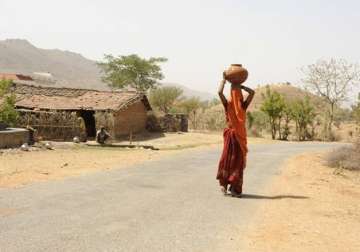In bulk of rural India, Rs.5,000 is highest wage
New Delhi : For nearly 75 percent of the 17.9 crore (nearly 180 million) households in rural India, the monthly income of the highest-earning member is less than Rs.5,000, ($83) even as close to 40
New Delhi : For nearly 75 percent of the 17.9 crore (nearly 180 million) households in rural India, the monthly income of the highest-earning member is less than Rs.5,000, ($83) even as close to 40 percent are landless and work as manual casual labourers for their daily bread, latest official data reveals.
This is the finding of the Socio Economic and Caste Census 2011 for Rural India released Friday that also shows that nearly 25 percent of the rural households still do not own a phone despite India boasting a telecom subscriber base of around a billion.
Also, among the the fortunate families that actually own land, the dependence on rains for their crops is rather high, with 25 percent having no access to irrigation, as pe the Census released by Finance Minister Arun Jaitley.
Only 8.29 percent of the rural households reported a member who was drawing more than Rs.10,000 per month, while for 17.18 percent others the monthly earning was between Rs.5,000 and Rs.10,000 per month.
The latest Census covered all the 640 districts in the country in a paperless manner, using some 640,000 electronic handheld devices. The government on Friday released only the provisional sdata of the socio-economic Census for rural India.
The Census seeks to provide useful data on households on various aspects of their socio-economic status -- housing, land-holding, education, women, the differently able, occupation, possession of assets, and members of scheduled castes and tribes.
In a bid to target government schemes better and ensure they the intended beneficiaries alone, it also provides for automatic exclusion of families on the basis of 14 parameters as also automatic inclusion on the basis of five criteria.
"The progress which households in India have made, who are the ones who have qualitatively moved up in terms of quality of life -- a document of these will be an important input for all policy makers, both at the Centre and in the states," Jaitley said in releasing the Census.
"I am sure that with the enormity of the schemes and their reaches that all governments have, this document will form the basis of helping us to target groups to support in terms of policy planning," the finance minister added.
Based on 14 parameters for families -- which include criteria such owing a vehicle, possessing a kisan credit card, having a serving government member, drawing an income of Rs.10,000 per month, or owing a refrigerator -- only 7.05 crore families (39.39 percent) stand to be excluded.
Similarly, based on five parameters -- households without shelter, those living on alms, manual scavengers, primitive tribals and legally released bonded labourers -- 16.50 lakh families are eligible for automatic inclusion.
At the same time, 10.69 crore (over 100 million) of rural families, or 60 percent, qualify for "deprivation" based on seven criteria -- which include those with one room, kuccha walls, no member in 18-59 age group, no literate adult above 25 years and landless households.
Among them, while 21.5 percent belong to scheduled castes or tribes, 23.5 percent are without a literate adulty above 25 years of age. This apart, 30 percent are landless households deriving a major part of their income from manual labour.
